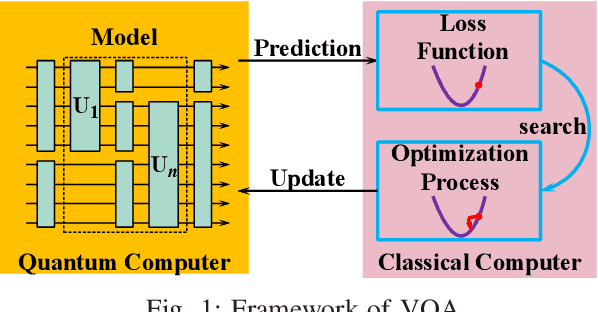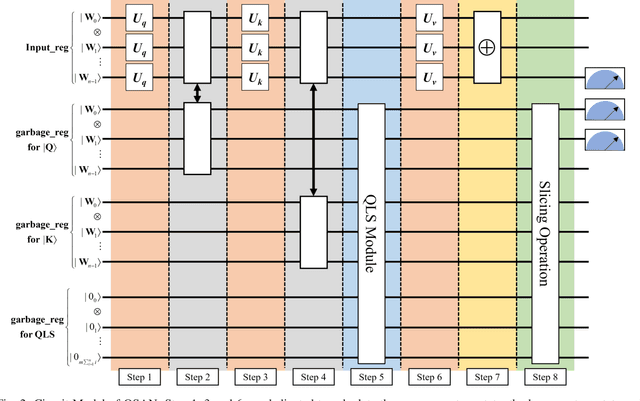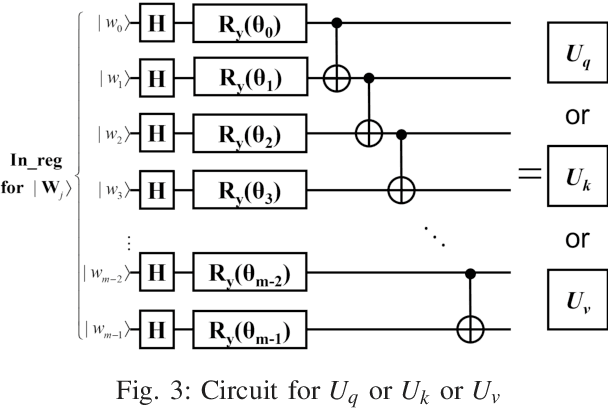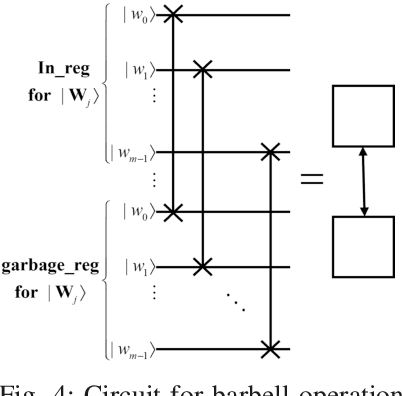Jinjing Shi
QAMA: Quantum annealing multi-head attention operator with classical deep learning framework
Apr 15, 2025Abstract:As large language models scale up, the conventional attention mechanism faces critical challenges of exponential growth in memory consumption and energy costs. Quantum annealing computing, with its inherent advantages in computational efficiency and low energy consumption, offers an innovative direction for constructing novel deep learning architectures. This study proposes the first Quantum Annealing-based Multi-head Attention (QAMA) mechanism, achieving seamless compatibility with classical attention architectures through quadratic unconstrained binary optimization (QUBO) modeling of forward propagation and energy-based backpropagation. The method innovatively leverages the quantum bit interaction characteristics of Ising models to optimize the conventional $O(n^2)$ spatiotemporal complexity into linear resource consumption. Integrated with the optical computing advantages of coherent Ising machines (CIM), the system maintains millisecond-level real-time responsiveness while significantly reducing energy consumption. Our key contributions include: Theoretical proofs establish QAMA mathematical equivalence to classical attention mechanisms; Dual optimization of multi-head specificity and long-range information capture via QUBO constraints; Explicit gradient proofs for the Ising energy equation are utilized to implement gradient conduction as the only path in the computational graph as a layer; Proposed soft selection mechanism overcoming traditional binary attention limitations to approximate continuous weights. Experiments on QBoson CPQC quantum computer show QAMA achieves comparable accuracy to classical operators while reducing inference time to millisecond level and improving solution quality. This work pioneers architectural-level integration of quantum computing and deep learning, applicable to any attention-based model, driving paradigm innovation in AI foundational computing.
Personalized Quantum Federated Learning for Privacy Image Classification
Oct 03, 2024



Abstract:Quantum federated learning has brought about the improvement of privacy image classification, while the lack of personality of the client model may contribute to the suboptimal of quantum federated learning. A personalized quantum federated learning algorithm for privacy image classification is proposed to enhance the personality of the client model in the case of an imbalanced distribution of images. First, a personalized quantum federated learning model is constructed, in which a personalized layer is set for the client model to maintain the personalized parameters. Second, a personalized quantum federated learning algorithm is introduced to secure the information exchanged between the client and server.Third, the personalized federated learning is applied to image classification on the FashionMNIST dataset, and the experimental results indicate that the personalized quantum federated learning algorithm can obtain global and local models with excellent performance, even in situations where local training samples are imbalanced. The server's accuracy is 100% with 8 clients and a distribution parameter of 100, outperforming the non-personalized model by 7%. The average client accuracy is 2.9% higher than that of the non-personalized model with 2 clients and a distribution parameter of 1. Compared to previous quantum federated learning algorithms, the proposed personalized quantum federated learning algorithm eliminates the need for additional local training while safeguarding both model and data privacy.It may facilitate broader adoption and application of quantum technologies, and pave the way for more secure, scalable, and efficient quantum distribute machine learning solutions.
QuanTest: Entanglement-Guided Testing of Quantum Neural Network Systems
Feb 20, 2024Abstract:Quantum Neural Network (QNN) combines the Deep Learning (DL) principle with the fundamental theory of quantum mechanics to achieve machine learning tasks with quantum acceleration. Recently, QNN systems have been found to manifest robustness issues similar to classical DL systems. There is an urgent need for ways to test their correctness and security. However, QNN systems differ significantly from traditional quantum software and classical DL systems, posing critical challenges for QNN testing. These challenges include the inapplicability of traditional quantum software testing methods, the dependence of quantum test sample generation on perturbation operators, and the absence of effective information in quantum neurons. In this paper, we propose QuanTest, a quantum entanglement-guided adversarial testing framework to uncover potential erroneous behaviors in QNN systems. We design a quantum entanglement adequacy criterion to quantify the entanglement acquired by the input quantum states from the QNN system, along with two similarity metrics to measure the proximity of generated quantum adversarial examples to the original inputs. Subsequently, QuanTest formulates the problem of generating test inputs that maximize the quantum entanglement sufficiency and capture incorrect behaviors of the QNN system as a joint optimization problem and solves it in a gradient-based manner to generate quantum adversarial examples. Experimental results demonstrate that QuanTest possesses the capability to capture erroneous behaviors in QNN systems (generating 67.48%-96.05% more test samples than the random noise under the same perturbation size constraints). The entanglement-guided approach proves effective in adversarial testing, generating more adversarial examples (maximum increase reached 21.32%).
GQHAN: A Grover-inspired Quantum Hard Attention Network
Jan 25, 2024Abstract:Numerous current Quantum Machine Learning (QML) models exhibit an inadequacy in discerning the significance of quantum data, resulting in diminished efficacy when handling extensive quantum datasets. Hard Attention Mechanism (HAM), anticipated to efficiently tackle the above QML bottlenecks, encounters the substantial challenge of non-differentiability, consequently constraining its extensive applicability. In response to the dilemma of HAM and QML, a Grover-inspired Quantum Hard Attention Mechanism (GQHAM) consisting of a Flexible Oracle (FO) and an Adaptive Diffusion Operator (ADO) is proposed. Notably, the FO is designed to surmount the non-differentiable issue by executing the activation or masking of Discrete Primitives (DPs) with Flexible Control (FC) to weave various discrete destinies. Based on this, such discrete choice can be visualized with a specially defined Quantum Hard Attention Score (QHAS). Furthermore, a trainable ADO is devised to boost the generality and flexibility of GQHAM. At last, a Grover-inspired Quantum Hard Attention Network (GQHAN) based on QGHAM is constructed on PennyLane platform for Fashion MNIST binary classification. Experimental findings demonstrate that GQHAN adeptly surmounts the non-differentiability hurdle, surpassing the efficacy of extant quantum soft self-attention mechanisms in accuracies and learning ability. In noise experiments, GQHAN is robuster to bit-flip noise in accuracy and amplitude damping noise in learning performance. Predictably, the proposal of GQHAN enriches the Quantum Attention Mechanism (QAM), lays the foundation for future quantum computers to process large-scale data, and promotes the development of quantum computer vision.
QKSAN: A Quantum Kernel Self-Attention Network
Aug 25, 2023Abstract:Self-Attention Mechanism (SAM) is skilled at extracting important information from the interior of data to improve the computational efficiency of models. Nevertheless, many Quantum Machine Learning (QML) models lack the ability to distinguish the intrinsic connections of information like SAM, which limits their effectiveness on massive high-dimensional quantum data. To address this issue, a Quantum Kernel Self-Attention Mechanism (QKSAM) is introduced, which combines the data representation benefit of Quantum Kernel Methods (QKM) with the efficient information extraction capability of SAM. A Quantum Kernel Self-Attention Network (QKSAN) framework is built based on QKSAM, with Deferred Measurement Principle (DMP) and conditional measurement techniques, which releases half of the quantum resources with probabilistic measurements during computation. The Quantum Kernel Self-Attention Score (QKSAS) determines the measurement conditions and reflects the probabilistic nature of quantum systems. Finally, four QKSAN models are deployed on the Pennylane platform to perform binary classification on MNIST images. The best-performing among the four models is assessed for noise immunity and learning ability. Remarkably, the potential learning benefit of partial QKSAN models over classical deep learning is that they require few parameters for a high return of 98\% $\pm$ 1\% test and train accuracy, even with highly compressed images. QKSAN lays the foundation for future quantum computers to perform machine learning on massive amounts of data, while driving advances in areas such as quantum Natural Language Processing (NLP).
QSAN: A Near-term Achievable Quantum Self-Attention Network
Jul 18, 2022



Abstract:Self-Attention Mechanism (SAM), an important component of machine learning, has been relatively little investigated in the field of quantum machine learning. Inspired by the Variational Quantum Algorithm (VQA) framework and SAM, Quantum Self-Attention Network (QSAN) that can be implemented on a near-term quantum computer is proposed.Theoretically, Quantum Self-Attention Mechanism (QSAM), a novel interpretation of SAM with linearization and logicalization is defined, in which Quantum Logical Similarity (QLS) is presented firstly to impel a better execution of QSAM on quantum computers since inner product operations are replaced with logical operations, and then a QLS-based density matrix named Quantum Bit Self-Attention Score Matrix (QBSASM) is deduced for representing the output distribution effectively. Moreover, QSAN is implemented based on the QSAM framework and its practical quantum circuit is designed with 5 modules. Finally, QSAN is tested on a quantum computer with a small sample of data. The experimental results show that QSAN can converge faster in the quantum natural gradient descent framework and reassign weights to word vectors. The above illustrates that QSAN is able to provide attention with quantum characteristics faster, laying the foundation for Quantum Natural Language Processing (QNLP).
 Add to Chrome
Add to Chrome Add to Firefox
Add to Firefox Add to Edge
Add to Edge